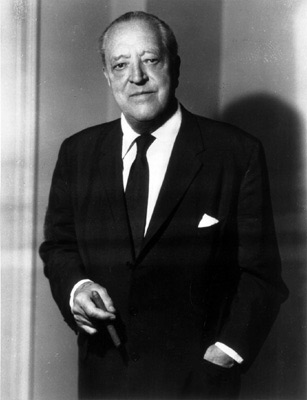
Ludwig Mies van der Rohe was a German-American architect, academic, and interior designer. He was commonly referred to as Mies, his surname. He is regarded as one of the pioneers of modern architecture.

Illinois Institute of Technology (IIT), commonly referred to as Illinois Tech, is a private research university in Chicago, Illinois. Tracing its history to 1890, the present name was adopted upon the merger of the Armour Institute and Lewis Institute in 1940. The university has programs in architecture, business, communications, design, engineering, industrial technology, information technology, law, psychology, and science. It is classified among "R2: Doctoral Universities – High research activity". The university's faculty and alumni include 3 Nobel Prize laureates, 2 Fulbright Scholarship recipients, and 1 recipient of the National Medal of Technology.

The Frederick C. Robie House is a U.S. National Historic Landmark now on the campus of the University of Chicago in the South Side community area of Hyde Park in Chicago, Illinois. Built between 1909 and 1910, the building was designed as a single family home by architect Frank Lloyd Wright. It is considered perhaps the finest example of Prairie School, the first architectural style considered uniquely American.
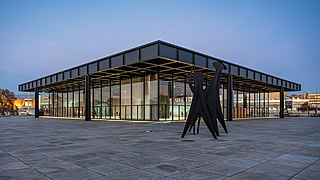
The Neue Nationalgalerie at the Kulturforum is a museum for modern art in Berlin, with its main focus on the 20th century. It is part of the National Gallery of the Berlin State Museums. The museum building and its sculpture gardens were designed by Ludwig Mies van der Rohe and opened on September 15th, 1968.

The Edith Farnsworth House, formerly the Farnsworth House, is a historical house designed and constructed by Ludwig Mies van der Rohe between 1945 and 1951. The house was constructed as a one-room weekend retreat in a rural setting in Plano, Illinois, about 60 miles (96 km) southwest of Chicago's downtown. The steel and glass house was commissioned by Edith Farnsworth.

Unity Temple is a Unitarian Universalist church in Oak Park, Illinois, and the home of the Unity Temple Unitarian Universalist Congregation. It was designed by the American architect Frank Lloyd Wright, and built between 1905 and 1908. Unity Temple is considered to be one of Wright's most important structures dating from the first decade of the twentieth century. Because of its consolidation of aesthetic intent and structure through use of a single material, reinforced concrete, Unity Temple is considered by many architects to be the first modern building in the world. This idea became of central importance to the modern architects who followed Wright, such as Ludwig Mies van der Rohe, and even the post-modernists, such as Frank Gehry. In 2019, along with seven other buildings designed by Wright in the 20th century, Unity Temple was added to the UNESCO World Heritage List.

The McCormick Tribune Campus Center (MTCC) is a building on the main campus of the Illinois Institute of Technology, in the Bronzeville neighborhood on the south side of Chicago. The McCormick Tribune Campus Center opened September 30, 2003. A single-story 110,000-square-foot (10,000 m2) building, it was the first building designed by architect Rem Koolhaas within the United States.
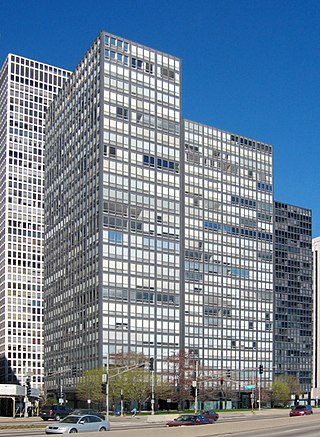
860–880 Lake Shore Drive is a twin pair of glass-and-steel apartment towers on N. Lake Shore Drive along Lake Michigan in the Streeterville neighborhood of Chicago, Illinois. Construction began in 1949 and the project was completed in 1951. The towers were added to the National Register of Historic Places on August 28, 1980, and were designated as Chicago Landmarks on June 10, 1996. The 26-floor, 254-ft tall towers were designed by the architect Ludwig Mies van der Rohe, and dubbed the "Glass House" apartments. Construction was by the Chicago real estate developer Herbert Greenwald, and the Sumner S. Sollitt Company. The design principles were copied extensively and are now considered characteristic of the modern International Style as well as essential for the development of modern high-tech architecture.

The MIT Chapel is a non-denominational chapel designed by noted architect Eero Saarinen. It is located on the campus of the Massachusetts Institute of Technology in Cambridge, Massachusetts, next to Kresge Auditorium and the Kresge Oval, which Saarinen also designed. Though a small building, the Chapel is often noted as a successful example of mid-century modern architecture in the United States. Saarinen also designed the landscaping surrounding all three locations.

S. R. Crown Hall, designed by the German-American Modernist architect Ludwig Mies van der Rohe, is the home of the College of Architecture at the Illinois Institute of Technology in Chicago, Illinois.
VanderCook College of Music is a private music school in Chicago, Illinois. It is the only college in the United States solely specializing in the training of music educators. Students may pursue a Bachelor of Music in Education (B.M.Ed.),Bachelor of Music in Performance and Pedagogy (B.M.Ped), Bachelor of Music, (B.M), Master of Music in Education (M.M.Ed.), and Master of Music in Education and Certification (M.Cert). The college is located in a Mies van der Rohe building on the campus of Illinois Institute of Technology (IIT). VanderCook is accredited by the Higher Learning Commission and the National Association of Schools of Music.
Alfred Caldwell was an American architect best known for his landscape architecture in and around Chicago, Illinois.

The Everett McKinley Dirksen United States Courthouse, commonly referred to as the Dirksen Federal Building, is a skyscraper in the Chicago Loop at 219 South Dearborn Street. It was designed by Ludwig Mies van der Rohe and completed in 1964. The building is 384 feet (117 m) tall with 30 floors; it was named for U.S. Congressman Everett Dirksen. The building houses the United States Court of Appeals for the Seventh Circuit, the United States District Court for the Northern District of Illinois, the United States Bankruptcy Court, the United States Marshal for the Northern District of Illinois, United States Attorney for the Northern District of Illinois, and local offices for various court-related federal agencies, such as the Federal Public Defender, United States Probation Service, United States Trustee, and National Labor Relations Board. It is one of three buildings making up the modernist Chicago Federal Center complex designed by van der Rohe, along with Federal Plaza, the U.S. Post Office and the Kluczynski Federal Building. Separate from the Federal Plaza, but opposite the Kluczynski Building across Jackson Boulevard, is the Metcalfe Federal Building.
Gene R. Summers was an American modernist architect. Considered to have been Mies van der Rohe's "right-hand man", he assisted his famed employer in the design of the iconic Seagram Building on Park Avenue on the island of Manhattan in New York City. Later, in private practice, he designed the huge McCormick Place convention center in Chicago, Illinois.
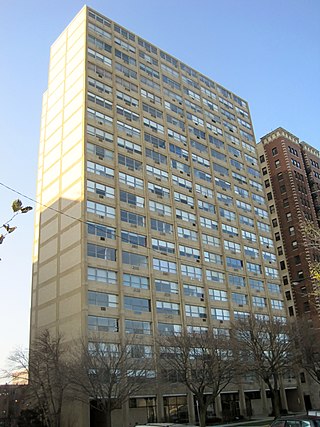
The Promontory Apartments is a 22-story skyscraper in Hyde Park, Chicago, Illinois, United States designed by Ludwig Mies van der Rohe. It was the first skyscraper Mies designed and was the first of his buildings to feature concepts such as an exposed skeleton. The cooperative building overlooking Burnham Park has 122 units.
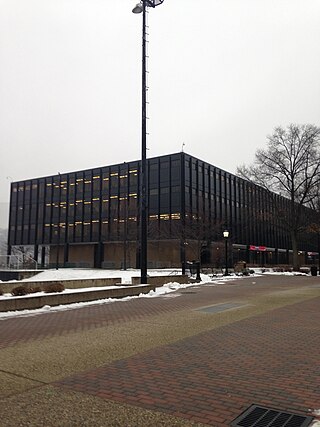
Richard King Mellon Hall of Science, also known as Mellon Hall, is an academic facility on the Duquesne University campus in Pittsburgh, Pennsylvania, United States.

The Home Federal Savings and Loan Association of Des Moines Building, also known as American Federal Savings and the Catholic Pastoral Center, is a historic building located in downtown Des Moines, Iowa, United States. Completed in 1962, it is considered to be "one of the most well-known examples of mid-century modern architecture in Des Moines." It was designed by the prominent Chicago architect Ludwig Mies van der Rohe, and it is one of the first steel and glass modernist buildings in the city's downtown. Initially, the roof was designed to be suspended from two lengthwise trusses, similar van der Rohe's designs at the Illinois Institute of Technology in Chicago. That design was abdoned for a simpler and more direct design that features a steel-frame, glass-infill, and granite and travertine marble on the base. The three-story building rises to the height of 40.25 feet (12.27 m). It was built for the Home Federal Savings and Loan Association of Des Moines and later American Federal Savings, which failed in 1990 amid the country's Savings and loan crisis. There was concern that the building would be torn down so the Des Moines City Council designated it as a local landmark. In 1992 philanthropist Ed Ochylski acquired it and donated it to the Diocese of Des Moines, who converted it into their headquarters. From 2016 to 2017, the building underwent a $10 million renovation. It was listed on the National Register of Historic Places in 2017.
Robert "Bob" Lawton Jones (1925-2018) was an American architect and academic recognized for his contributions to modernist architecture.

900 910 North Lake Shore are a pair of glass and steel buildings, perpendicular to one another, designed by architect Ludwig Mies van der Rohe, in the Streeterville neighborhood of Chicago. Completed in 1956, they marked the refinement of Mies' highrise building design concept. The buildings are built to a Modernist International style that was considered to be a departure from the dominant aesthetic at the time they were built, and even criticized as too minimal. The "glass houses" are more often appreciated for the views they offer of Lake Michigan and downtown Chicago. The buildings were referred to as “giant mirrors for lake beauty”.
Carman Hall is a dormitory owned by the Illinois Institute of Technology.



















